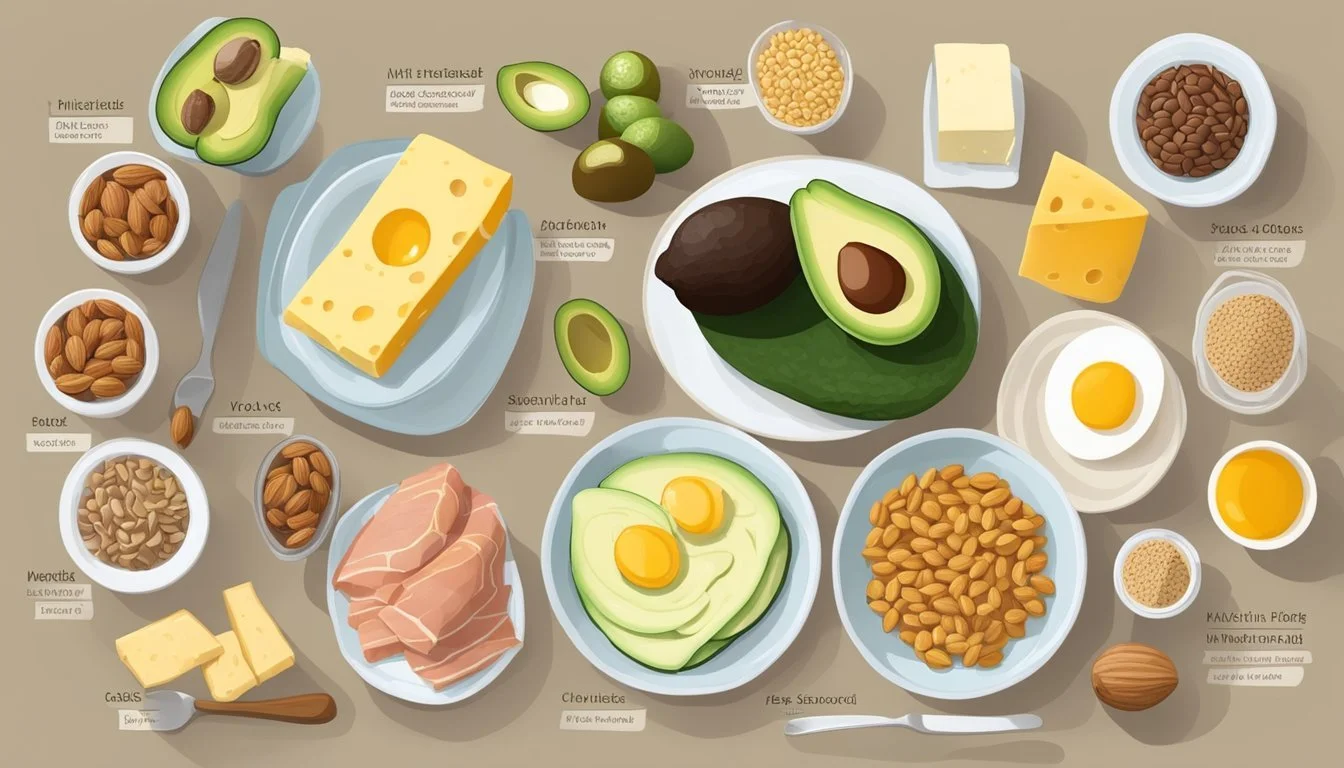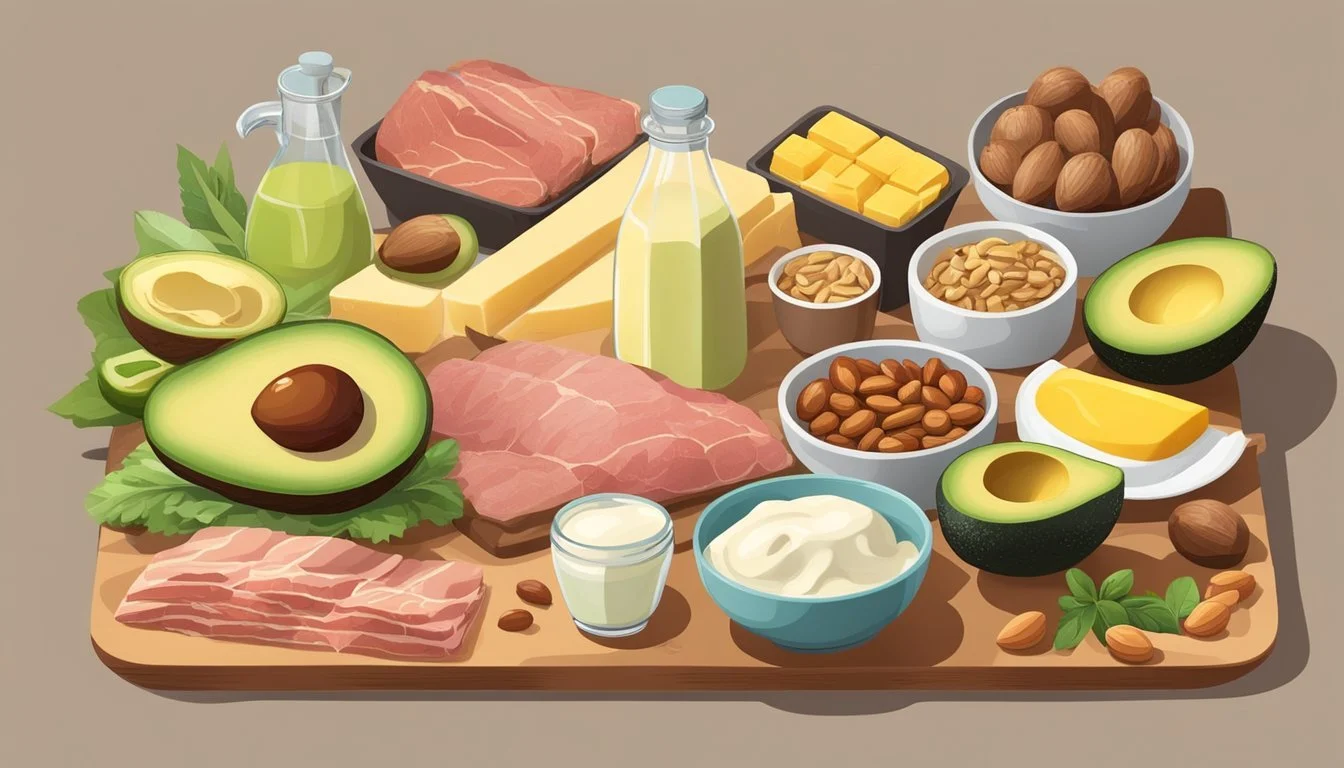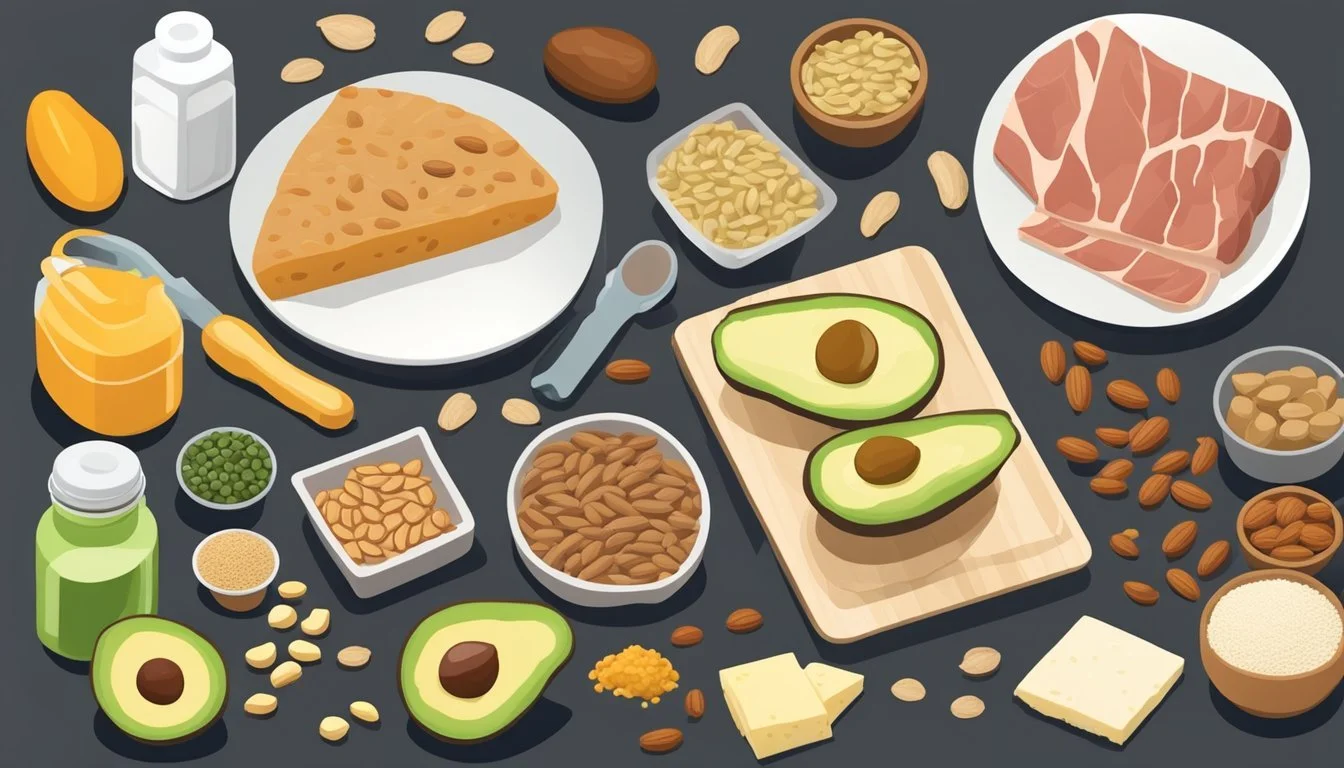High-Fat Diet: Ensuring Adequate Protein Intake
A high-fat diet, often embraced for various health and lifestyle reasons, must be balanced with adequate protein intake to support bodily functions and maintain muscle mass. Protein is an essential nutrient that plays a critical role in repairing tissues and supporting immune health. The Recommended Dietary Allowance (RDA) for protein as advised by the Dietary Guidelines for Americans is at least 46 grams per day for women and 56 grams for men, although needs can vary based on an individual's health status, level of activity, and overall dietary goals.
In the context of a high-fat diet, incorporating sufficient protein can seem challenging, given the macronutrient focus on fats. However, it is essential to ensure that one's protein sources align with the diet's requirements. Strategic incorporation of high-protein foods that are either low in carbohydrates or fit within the dietary fat ratio is key. This may include options like fatty fish, which provides both high-quality protein and healthy fats, or lean meats and dairy products, which offer substantial protein content without excessive carbs.
Understanding the balance and distribution of macronutrients is vital when following a high-fat diet. Individuals must consider the quality of protein sources, aiming to include complete proteins that contain all essential amino acids. Eggs, meat, and dairy products not only fulfill the protein requirement but are also pivotal in a high-protein and high-fat dietary plan. This strategic approach to diet ensures that one's protein needs are met while adhering to the high-fat dietary guidelines.
Understanding Proteins and Fats
Proteins and fats are both crucial macronutrients in a balanced diet; they play distinct and vital roles within the body's functioning and maintenance.
Role of Protein in the Body
Proteins, composed of amino acids, are critical for the body's growth, development, and repair. They are involved in key body processes such as muscle mass development, tissue repair, hormones synthesis, and supporting the immune response. There are 20 amino acids, of which nine are essential because the body cannot synthesize them and they must be acquired through diet.
Importance of Fats
Fats are a dense source of energy, providing 9 calories per gram. They contribute to the absorption of fat-soluble vitamins and are crucial for building cell membranes. Dietary fats are also important for brain health and the production of certain hormones. However, it is important to manage the intake of saturated fats, as they can negatively influence body composition and elevate LDL cholesterol levels.
Balancing Macronutrients
A balanced diet includes an appropriate mix of macronutrients: proteins, fats, and carbohydrates. The balance of these nutrients is important for maintaining a healthy body weight and metabolism. Fiber, a type of carbohydrate, is essential for digestive health. Adjustments to the balance of these macronutrients can influence body composition and dietary satisfaction.
Recommended Dietary Allowance (RDA) for Protein
For proper nutrition, the Recommended Dietary Allowance (RDA) for protein is 56 grams per day for adult males and 46 grams per day for adult females. These values are key for individuals seeking to maintain sufficient protein intake while managing overall calories and nutrients within a high-fat diet framework. Protein foods should be chosen wisely to contribute to this intake while considering the entire nutrient profile of the food source.
High-Fat Protein Sources
In this section, readers will explore high-fat protein sources that can perfectly complement a high-fat diet. These offerings balance a significant protein content with healthy fats, making them suitable for those aiming to follow a high-fat nutritional plan.
Meaty Options
Meat remains a staple source of both protein and fat. Options like steak, pork, and red meat are rich in protein and contain the high levels of saturated fats often sought in a high-fat diet. Notably, chicken breast provides an excellent balance of protein while being relatively lean, which can then be augmented with healthy oils or sauces to increase fat content.
Lean Beef: A 3-ounce serving contains roughly 22 grams of protein.
Pork: Comparable servings yield nearly 25 grams of protein.
Seafood Selections
Seafood offers a range of high-fat protein options, including salmon, which is celebrated for its omega-3 fatty acids and approximately 23 grams of protein per 4-ounce serving. Other fatty fishes like tuna also support a high-fat diet, providing both protein and a healthy dose of fats.
Shrimp: Contains about 20 grams of protein per 3-ounce serving and is a versatile high-protein addition to many dishes.
Dairy Delights
Dairy products can be an excellent aspect of a high-fat, high-protein diet. Greek yogurt, cottage cheese, and certain cheeses pack a high-protein punch with the added benefit of dietary fats, provided one opts for full-fat versions.
Greek Yogurt: Roughly 17 grams of protein per 6-ounce serving.
Cheese: Varied in type, cheese can offer between 6 to 10 grams of protein per ounce.
Plant-Based Proteins
For a plant-forward approach to high-fat proteins, nuts, seeds, quinoa, and soy products fit seamlessly into this category. They offer not just protein and fats but also essential fibers and micronutrients.
Nuts and Seeds: Provide an average of 5 to 7 grams of protein per ounce.
Legumes: Including beans and lentils, average about 15 grams of protein per cooked cup.
Protein Powders and Supplements
Protein supplements, particularly protein powders derived from whey or casein, are an efficient way to increase protein intake without significantly altering the fat content in one's diet. They can be blended into high-fat smoothies using ingredients like nut butters or full-fat dairy.
Protein Powder: On average, one scoop can deliver between 20 to 30 grams of protein, variable by brand and type.
Incorporating Protein into a High-Fat Diet
A high-fat diet can be protein-rich with the right food choices and meal planning. The balance of macronutrients is key to achieving health goals within this eating plan.
Whole Foods Approach
Incorporating protein into a high-fat diet often relies on whole foods. They should be unprocessed and high in nutritional value.
Vegetables: Options like broccoli and spinach are not only rich in nutrients but also contain moderate amounts of protein.
Nuts and Seeds: Including almonds and seeds such as chia or flaxseed, which can boost protein intake while providing healthful fats.
Dairy Products: Choices like full-fat cheese and Greek yogurt offer both protein and fat content ideal for a high-fat diet.
Strategic Snacking
Smart snacking is an effective way to supplement protein intake throughout the day.
Nuts: A handful of nuts like almonds can be a quick, protein-rich snack.
Almond Butter: Used as a dip for veggies or a spread, it's an excellent source of both protein and healthy fats.
Avocado: (how long does avocado last?) Eaten alone or in recipes, avocados provide good fats and a decent amount of protein.
Eggs: Boiled eggs are a portable and convenient snack high in protein and fats.
Meal Planning and Recipes
Developing a meal plan with an emphasis on high-protein recipes is crucial for maintaining a high-fat diet.
Breakfast: An omelet with spinach, cheese, and avocado incorporates protein and healthy fats.
Lunch: A salad with grilled chicken, almonds, and seeds sprinkled over top, dressed with olive oil.
Dinner: Broccoli and cheese casserole with a side of seasoned pork loin, focusing on both high-fat and protein foods.
By using a combination of whole foods, strategic snacking, and carefully considered recipes, individuals can enjoy a rich variety of protein sources within a high-fat dietary framework.
Special Dietary Considerations
Individuals pursuing a high-fat diet with enough protein intake must consider their specific health goals and needs. Here's how various health factors interplay with a high-protein, high-fat dietary approach.
Weight Loss Goals
For those aiming to lose weight, protein can enhance feelings of fullness, which may help reduce overall calorie consumption. A diet high in protein-rich foods such as lean meats and legumes, combined with healthy fats, can increase satiety and manage appetite. However, balancing macronutrients to ensure a low-carb and low-fat intake may also be necessary for effective weight loss.
Diabetes Management
Protein plays a critical role in stabilizing blood sugar levels, making it an important factor for those managing diabetes. Including fiber-rich foods like beans, grains, and seeds can further aid in blood sugar control. Opt for sources of protein and fats that do not contribute to unhealthy blood sugar spikes.
Heart Health
When considering heart disease, it's key to focus on the types of fats consumed. Incorporating omega-3 fatty acids found in fatty fish can be beneficial for heart health. Protein sources should be varied and include plant-based options like legumes and seeds to minimize intake of unhealthy saturated fats.
Kidney Disease and Protein Intake
Individuals with kidney disease need to monitor their protein intake carefully, as an excessive amount can worsen kidney function. It is important to consult healthcare providers to determine the appropriate level of protein. The focus should be on high-quality, protein-rich foods that are not overly taxing on the kidneys.
Avoiding Common Pitfalls
When aiming for a high-protein, high-fat diet, it's crucial to navigate the landscape of dietary choices with an awareness of the associated health risks and nutritional balance.
Managing Saturated Fat Intake
Saturated fat is often abundant in a high-fat diet, particularly when one consumes large amounts of red meat and full-fat dairy products. The Dietary Guidelines for Americans recommend limiting saturated fat to less than 10% of daily calorie intake, as excess consumption can increase the risk of heart disease.
Recommended food sources: Opt for lean cuts of meat, skinless poultry, and fatty fish.
Preparation techniques: Prepare meats by grilling, baking, or broiling rather than frying.
Risks of Processed Meat
Processed meats, while convenient and protein-rich, typically contain high levels of saturated fat and additives like sodium and nitrates. They pose health risks such as increased rates of heart disease and cancer.
Limit processed meats: Aim to limit or avoid items like bacon, sausages, and deli meats.
Healthier alternatives: Choose fresh, unprocessed meats and use herbs and spices for flavoring instead of relying on processed products.
Balancing Variety and Preferences
A balanced diet incorporates a variety of protein sources, allowing for adequate nutrient intake and aligning with individual taste preferences and lifestyle needs.
Diverse sources: Incorporate a mix of seafood, legumes, eggs, and dairy to ensure a range of nutrients.
Tailoring to lifestyle: Consider one's activity level, dietary restrictions, and health goals to make appropriate protein choices that complement high-fat consumption.
By being mindful of these pitfalls, individuals can better align their high-protein, high-fat diet with overall health objectives and personal preferences.
Supplementary Information
This section offers guidance on navigating nutritional labels and additives, the role of carbohydrates and fiber in a high-fat, protein-rich diet, and strategies for enhancing the flavor of meals while maintaining nutritional balance.
Understanding Labels and Additives
When selecting protein sources, individuals should scrutinize labels to identify additives. Added sugars or excessive sodium can undermine the health benefits of high-protein foods. Labels are crucial in distinguishing between pure protein sources and those with unwanted additives. Reading labels carefully can reveal hidden ingredients that could impact one's dietary goals.
Look for: "No added sugars", "low sodium", and specific protein content per serving.
Avoid: Additives like monosodium glutamate (MSG), high fructose corn syrup, or artificial preservatives when selecting high-protein products.
Discussion on Carbohydrates and Fiber
A high-fat diet often calls for lower carbohydrate intake, but quality and type of carbohydrates are critical. Fiber is essential for digestive health. Whole grains, despite being carbohydrate-rich, contribute valuable fiber and nutrients.
Preferred carbohydrates: Include complex carbs like sweet potato, oatmeal, and brown rice to provide sustained energy and fiber.
Fiber sources: Seek out high-fiber foods such as legumes and certain vegetables to complement the diet's protein and fat components.
Enhancing Flavor without Compromising Nutrition
To maintain a flavorful diet without adding unnecessary fats or sugars, one should leverage herbs and spices. They not only enhance flavor but also can contribute to the overall nutritional profile of the meal.
Herbs: Fresh or dried options like basil, thyme, and cilantro can significantly augment the taste of protein-centric dishes.
Spices: Utilize spices such as turmeric, paprika, and garlic powder to increase the palatability of food without compromising its health benefits.
Using spices and herbs effectively eliminates the need for high-calorie sauces and dressings that can detract from the high-protein, high-fat dietary objectives.
Conclusion
Incorporating enough protein into a high-fat diet is crucial for managing hunger, supporting muscle health, and maintaining strength. While it might seem challenging, several strategies can ensure adequate protein intake.
Choose Protein-Rich Foods: Opt for foods that have a high protein-to-fat ratio. Examples include lean meats, seafood, and low-carb dairy.
Smart Snacking: Include snacks like seeds or nuts, which offer additional protein and healthy fats.
Meal Planning: Prioritize protein at each meal, ensuring it takes precedence over other macronutrients.
People may experience cravings when adjusting to a high-fat, adequate-protein diet. It's important to identify protein-rich foods that are also satisfying. Substituting certain high-carb items with protein-forward options can help mitigate these cravings and assist with adherence to dietary goals.
When followed correctly, a high-fat diet with sufficient protein can contribute to a sense of fullness and preserve lean body mass. Monitoring the body’s response to dietary changes is recommended to ensure the desired outcomes are being met and to make adjustments as needed.
Appendices
This section of the article serves as a practical guide to help readers personalize their high-protein, high-fat dietary choices.
Calculating Your Own Protein Needs
Every individual's protein requirements vary based on body weight and activity level. A general guideline for protein intake is 0.8 grams per kilogram of body weight, but those on a high-protein diet or with more active lifestyles may aim for higher, around 1.2 to 2.0 grams per kilogram of body weight. To calculate specific needs, one should multiply their body weight in kilograms by the recommended grams of protein.
Sample High-Protein, High-Fat Meal Plans
Day 1:
Breakfast: Scrambled eggs with avocado and a side of spinach
Lunch: Grilled chicken salad with olive oil dressing
Dinner: Pan-seared salmon with asparagus and a slice of cheese
Day 2:
Breakfast: Full-fat Greek yogurt with almonds and chia seeds
Lunch: Tuna salad stuffed in avocado halves
Dinner: Ribeye steak (What wine goes well with ribeye steak?) with sautéed mushrooms and a side of broccoli
These meal plans exemplify how one can pair protein-rich foods with healthy fats to create satiating and nutritious meals that align with a high-protein, high-fat eating plan.
FAQs About High-Protein Diets
Q: Is a high-protein diet suitable for everyone? A: Individual health conditions and dietary needs can vary, so it's advisable to consult with a healthcare provider or dietitian before embarking on a high-protein diet.
Q: Can a high-protein diet aid in weight loss? A: Increasing protein intake can enhance satiety and help reduce overall calorie consumption, potentially aiding in weight loss.
By considering one's personal protein requirements and preferences, individuals can tailor a high-protein, high-fat diet to fit their lifestyle, often resulting in improved satiety and potential weight management benefits.








